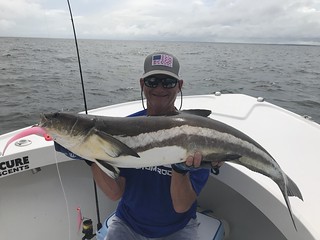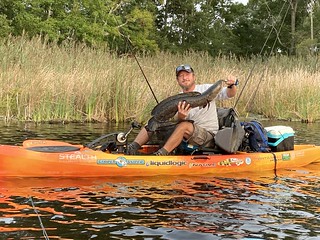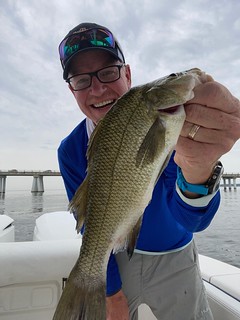Maryland Fishing Report – September 23

Young Fhinn Zeender-Lawrence joined family for fishing in the upper Choptank River, and shows off a 20-pound carp he caught before releasing it. Photo by Nathan Zeender
Welcome to the first week of fall! The cooler transitional days ahead are a delight for anyone who loves the outdoors. The leaves are beginning to show a hint of color in the western region of the state, so make sure to get outside and enjoy this special time of the year.
The upcoming week will bring cooler days, moderate winds and low chance of rain all week, continuing to cool Chesapeake Bay waters. Bay surface water temperatures have cooled to the upper 60s and low 70s and this trend will continue. These dense, cooling surface waters will sink, mixing the bay’s water from surface to bottom. This will result in cool-water preferring fish being able move more vertically in many areas and be more scattered until turnover conditions stabilize. As a result of the below normal flows from the Susquehanna, upper bay salinities are slightly higher than normal. As always, best fishing areas could be further refined by intersecting them with underwater points, hard bottom, drop-offs, and large schools of baitfish.
Expect average flows for most Maryland rivers and streams. There will be above average tidal currents Sunday through Tuesday as a result of the upcoming full moon on Oct. 2.
Expect average clarity for Maryland portions of the bay except the Northeast, Bush, Back, Patapsco, middle Chester, and middle Patuxent rivers.
To see the latest water clarity conditions, check Eyes on the Bay Satellite Maps.
For more detailed and up-to-date fishing conditions in your area of the bay, be sure to check out Click Before You Cast. Get regular updates on Maryland’s waters sent to your inbox with our Eyes on the Bay newsletter. Sign up online
At the Conowingo Dam pool and the lower Susquehanna River the best fishing tends to be for a mix of catfish species. Large flathead catfish are being caught in the dam pool and a mix of blue catfish, channel catfish and smaller flatheads in the river and the channels leading to the mouth of the river. Fresh cut bait from gizzard shad, menhaden, or white perch make great baits as do clam snouts and nightcrawlers. The tidal rivers of the upper bay and the bay hold large numbers of channel catfish and the rivers are hosting increasing numbers of blue catfish.
The striped bass fishing has been a bit on the slim side from the dam pool down to the flats. There has been some early morning and evening action but most of the fish being caught fall short of the 19-inch minimum. There has been little power generation at the dam until Sunday when mid-day water releases begin once again.
Fishing for striped bass picks up once you enter the waters around Pooles Island, where large fish in the upper 20s to 33-inch size range are being caught by trolling and live lining eels. There is also action on various lumps, knolls, and shoals in the upper bay, and the mouth of the Chester and Patapsco rivers is a good place to troll lately. A mix of spoons, Storm shads and hoses are a popular trolling spread behind inline weights and planers.
Breaking fish are being spotted in the upper bay which are mostly 2-year old striped bass chasing bay anchovies. Larger striped bass can often be found deeper underneath the surface action close to the bottom. Jigging with soft plastics is a popular way to fish for them. The Love Point Rocks are another great place to jig as are the Bay Bridge piers and rock piles. Live lining is also popular at the Bay Bridge.
Fishing for white perch has been good at the Bay Bridge piers and the lower portions of the tidal rivers in the upper bay. They are starting to feel the urge to leave their summer habitat near shoreline structure areas but there are still enough around to entertain anglers casting beetle-spins and spinners or fishing with grass shrimp near docks and piers. They are beginning to show up on oyster lumps in the tidal rivers though and this movement will increase in the next couple of weeks as water temperatures drop.
As water temperatures continue to drop rather rapidly, the middle bay is slipping into a fall pattern of fish behavior. The Spanish mackerel are feeling the urge to head to warmer waters and many may be far south by the weekend. The northeast winds earlier this week and cold nights are driving these changes. Bluefish will be the next to follow and the focus will shift to striped bass fishing.
Before the northeast winds a mix of Spanish mackerel, bluefish, and small striped bass were being seen chasing bay anchovies from Poplar Island south. This topwater action will steadily shift to primarily striped bass in the coming weeks and trolling and jigging will take center stage. Light-tackle jigging is one of the wonderful ways to fish for striped bass. The fish are fattening up and developing broad shoulders and the deep translucent purple overtones that we all love. These are striped bass at their finest.
As water temperatures in the tidal rivers dip lower, baitfish in the form of juvenile menhaden and bay anchovies will be pouring out of the tidal rivers and swept along by swift current along channel edges. Trolling umbrella rigs with bucktails dressed with sassy shads as trailers and a mix of spoons and hoses are also good additions to a trolling spread. When jigging, braided line helps with sensitivity in feeling a striped bass picking up a jig. Both metal jigs such as Crippled Herrings and skirted soft plastic jigs are equally popular.
Presently the east side of the shipping channel from Poplar Island south past Buoy 83 has been a good place to jig or troll, as have the edges off Thomas Point, in front of Chesapeake Beach, and the mouths of the Choptank and the Little Choptank rivers.
White perch are still being found holding in their summer habitat locations this week in the tidal rivers and creeks, but they will soon be moving down the tidal rivers and hold in deeper waters over oyster bars before heading to even deeper water in another two months. Casting beetle-spins, spinners, small jigs and of course fishing with grass shrimp or pieces of bloodworms on simple bottom rigs. When fishing over the oyster bars dropper rigs with small flies or pieces of bloodworm on hooks work well.
The shallow-water fishery for a mix of striped bass and speckled trout remains very good this week with the morning action lasting longer and starting earlier in the evenings. Topwater fishing provides some of the most exciting fishing action with poppers and floating jerkbaits. Skipping bugs are the most fun way for fly casters to fish the shallows in the lower sections of the tidal rivers and bay shores. The speckled trout will hit topwater lures and paddle tails in white and pearl sparkle.

Lonnie Johnson holds up a nice cobia he caught by casting a large soft plastic jig. Photo by Travis Long
Anglers will be out in force this week to see if cobia and Spanish mackerel are still holding in good numbers now the northeast winds have subsided. The last reports had cobia schooled up along the eastern side of the shipping channel from north of Buoy 76 south to 72B along the steep channel edge that drops from 25 feet to 110 feet. Boats had been stacked in the area trolling hoses and large spoons as well as sight-casting with live eels and large soft plastic jigs. Hopefully the action continues through the weekend. Large red drum are also being caught by those trolling for cobia.

Bo Shaffer was culling his catch of sooks and when he grabbed one a whole string of them held on for the ride back into the river. Photo by Slim Manthey
There continues to be breaking fish in the region made up of a mix of bluefish, Spanish mackerel, and in some cases striped bass. The real bounty lies below in the form of large red drum which make for some exciting catch-and-release action. Jigging close to the bottom with large soft plastic jigs, spoons, or an all-time favorite, Crocodile spoons, which are heavy enough to get down deep quickly.
Those targeting the Spanish mackerel will continue to troll at a good clip pulling small Drone or Clark spoons in gold and color combinations behind #1 and #2 planers or heavy inline weights. Trolling speeds will be slower for striped bass and bluefish and umbrella rigs with bucktail sassy shad combos for trailers. Spoons pulled behind inline weights as well as hoses are also popular. The channel edge from St. Georges Island to Piney Point in the lower Potomac has been a very productive location for larger striped bass.
Fishing for spot is about as good as it could ever be with bountiful catches being reported in the lower Patuxent River and Tangier Sound. White perch are mixing in and a few kingfish and speckled trout are also being caught. Pieces of bloodworm and wild shrimp pieces have been making the best baits. Peeler crab has been working well for speckled trout. The flounder seem to have left the Tangier Sound area; most likely they are headed south for the mouth of the bay and their fall offshore venture.
The strong northeast winds we experienced earlier this week and a week of very cold nights have caused water temperatures in the tidal rivers to dramatically drop. As a result, catches have dropped off significantly. The best places to explore for crabs would be the deeper waters as crabs begin their migration to deeper waters. Razor clams continue to be the best bait for producing good catches but chicken necks will also work. Female crabs or sooks tend to be very plentiful as they begin their exit from the tidal rivers and can really chew up baits quickly.
Water levels in the western region’s streams and rivers are still running low and clear and are reported to be improving. Until the put-and-take trout management waters begin to be stocked in early October, the catch-and-release areas offer the best and enjoyable fall fishing for trout. Leaves will begin to fall adding a little interference when casting with a fly rod or spinning rod. For fly fishing a variety of terrestrials, ants, streamers, and nymphs are all working well. Casting small jerkbaits, spinners, and small spoons are great ways to cover water when using ultra-light spinning tackle with a light line looking for holdover trout.
The upper Potomac water levels are also low and the waters are gin-clear. A stealthy approach, long casts with light line will help pave the way to successful fishing for smallmouth bass this week. Casting tubes and crankbaits near current breaks, large boulders and submerged ledges are a good tactic. Grass beds are beginning to decline and fall apart due to shorter daylight and leaves are beginning to be seen floating on the river making for more difficult fishing.

Don Goff holds up a whopper-sized northern snakehead with an equally big smile! Photo courtesy of Don Goff
Lower water temperatures in reservoirs, ponds, and tidal rivers are causing largemouth bass to be more aggressive and feeding all day long. In tidal rivers main river points, drop-offs and submerged wood are good places to target. As grass beds begin to decline, baitfish and crayfish will begin to head for deeper water and cover to wait out the winter months. Knowing this, it would be a good idea to cast crankbaits and plastics towards shallower waters and retrieve them towards the deeper drop-offs and transition zones where the largemouth will be waiting. When you’ve reached the dropoff, allow the bait to slowly descend off the edge.
In areas where the grass beds are still green, those areas as well as feeder creeks and lily pads are good places to work a variety of plastic baits, spinnerbaits and topwater lures. Spinnerbaits and Rat-L-Traps are often good choices for working around the edges of grass beds. In tidal areas this is especially true on a low tide.
Northern snakeheads will be part of the mix in tidal waters when fishing near grass. They will continue to hold tight to grass but will also be found near sunken shoreline brush and fallen wood. Frogs, chatterbaits, and buzzbaits are good lures to work over grass. It is pretty hard to beat a white paddle tail rigged weedless and fished with no weight or very little near grass or shoreline wood.
Crappie are schooling up near deep structure and can provide plenty of good fishing and eating. Rigging small minnows or small crappie jigs under a slip bobber is a good tactic. Fallen tree tops, bridge piers, and marina docks are all good places to look for them.
There is good fishing for a mix of kingfish and spot in the surf area of Ocean City and Assateague; pieces of bloodworm are the most popular bait. The pompano seem to have moved out of the region but croaker have replaced them and they can be caught on squid along with flounder. Bluefish are being caught on finger mullet and cut bait from spot.
At the inlet, sheepshead are being caught along the jetty rocks on sand fleas and pieces of green crab. Bluefish are moving in and out of the inlet on the tides and flounder fishing has been good. Striped bass are being caught in the evenings by live lining mullet, spot, or menhaden but most continue to fall short of the 28-inch minimum.
Recent strong northeast winds have caused water clarity to be greatly reduced, hopefully calmer weather will improve water clarity soon which is very important for good flounder fishing. Nice-sized croakers have moved into the coastal bays and are providing some great fishing. The largest flounder are usually caught by live lining small mullet, menhaden, or spot. Working large Gulp baits in white or pink are another way to target the larger flounder.
The Ocean City fleet is once again heading out to the offshore wreck and reef sites now that the northeast winds have subsided. They are finding limit catches of fat sea bass, and a nice mix of large flounder and a few small dolphin are still in the region.
The offshore canyons will beckon those looking for yellowfin tuna and white marlin releases this weekend now that sea conditions are calmer. Longfin albacore usually show up this time of September and schools of medium-sized bluefin tuna will be making their way south soon, and this may be the weekend when they are encountered by the Ocean City fleet.
For folks looking for a last shot at marlin, a reminder that NOAA Fisheries has determined that the Atlantic blue marlin, white marlin, and roundscale spearfish landings limit has been met and exceeded for 2020. Under applicable regulations, only catch-and-release fishing is permitted for these species through Dec. 31 in all areas of the Atlantic Ocean. Anglers are reminded that Atlantic billfish that are released must be handled in a manner that will maximize survival, and without removing the fish from the water. For additional information on safe handling, see NOAA’s Careful Catch-and-Release brochure.
“If you hunt or fish a couple of weeks in a row without reading newspapers or watching television, a certain not altogether deserved grace can reenter your life.” — Jim Harrison
Maryland Fishing Report is written and compiled by Keith Lockwood, Maryland Department of Natural Resources fisheries biologist.
Click Before You Cast is written by Tidewater Ecosystem Assessment Director Tom Parham.
This report is now available on your Amazon Echo device — just ask Alexa to “open Maryland Fishing Report.”



 1-888-373-7888
1-888-373-7888 233733
233733